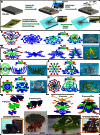Mechanical assembly of complex, 3D mesostructures from releasable multilayers of advanced materials
- PMID: 27679820
- PMCID: PMC5035128
- DOI: 10.1126/sciadv.1601014
Mechanical assembly of complex, 3D mesostructures from releasable multilayers of advanced materials
Abstract
Capabilities for assembly of three-dimensional (3D) micro/nanostructures in advanced materials have important implications across a broad range of application areas, reaching nearly every class of microsystem technology. Approaches that rely on the controlled, compressive buckling of 2D precursors are promising because of their demonstrated compatibility with the most sophisticated planar technologies, where materials include inorganic semiconductors, polymers, metals, and various heterogeneous combinations, spanning length scales from submicrometer to centimeter dimensions. We introduce a set of fabrication techniques and design concepts that bypass certain constraints set by the underlying physics and geometrical properties of the assembly processes associated with the original versions of these methods. In particular, the use of releasable, multilayer 2D precursors provides access to complex 3D topologies, including dense architectures with nested layouts, controlled points of entanglement, and other previously unobtainable layouts. Furthermore, the simultaneous, coordinated assembly of additional structures can enhance the structural stability and drive the motion of extended features in these systems. The resulting 3D mesostructures, demonstrated in a diverse set of more than 40 different examples with feature sizes from micrometers to centimeters, offer unique possibilities in device design. A 3D spiral inductor for near-field communication represents an example where these ideas enable enhanced quality (Q) factors and broader working angles compared to those of conventional 2D counterparts.
Keywords: 3D Assembly; buckling; microfabrication; multilayer; near field communication.
Figures





References
-
- Rogers J., Huang Y., Schmidt O. G., Gracias D. H., Origami MEMS and NEMS. MRS Bull. 41, 123–129 (2016).
Grants and funding
LinkOut - more resources
Full Text Sources
Other Literature Sources

